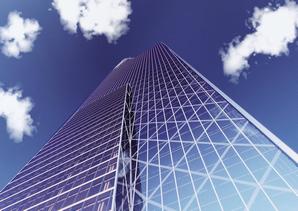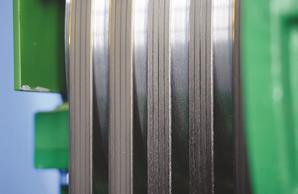By Catherine Kavanaugh
STAFF REPORTER
Published: October 28, 2014 1:55 pm ET
Updated: October 28, 2014 2:01 pm ET

Image By: Kone Corp.
Kone Corp.'s UltraRope will help elevators reach the top of the 3,281-foot-high Kingdom Tower when it opens in 2018.
Skyscrapers will be able to soar to greater heights with help from plastic in the latest lift technology developed by Kone Corp., an elevator and escalator maker based in Helsinki.
Kone put a high-friction polyurethane coating over a carbon fiber core to create what it calls UltraRope. The hoisting innovation is much lighter and stronger than conventional steel rope, giving it an energy efficiency edge for Kone to highlight at Greenbuild International 2014 in New Orleans, from Oct. 22-24.
UltraRope could enable high-rise elevators to travel heights up to 1 kilometer, which is 3,281 feet, or 0.62 miles. That’s twice the distance currently feasible.
“The new ultra-light rope technology eliminates the disadvantages of existing steel ropes — high energy consumption, rope stretch, large moving masses, and downtime caused by building sway,” Santeri Suoranta, director of Kone’s high rise platforms, said in an email.
Moving mass refers to the weight of everything that moves — ropes, counterweight, elevator car and passengers — when an elevator travels up or down. Steel rope becomes too heavy to pull people up beyond certain points. However, the reduced weight of Kone’s plastic-coated rope puts greater heights and energy efficiency within reach.
How big a leap the technology takes the construction industry remains to be seen, but Kone is in the process of filling some tall orders for UltraRope, including what promises to be the tallest building in the world. Called Kingdom Tower, the edifice is going up in Jeddah, Saudi Arabia.
Kingdom Tower is expected to reach a height of 1 kilometer, which would leave the current record set in 2010 in its dust. That distinction goes to the 828-meter (2,716-foot) Burj Khalifa in Dubai, United Arab Emirates. Although foundation work just wrapped up for the record challenger, the final floor count of the structure still isn’t known.
“The exact number of floors might still change, but we’re talking about something between 150 and 170 floors,” Suoranta said.
So far, the plans call for a seven-story, five-star Four Seasons Hotel; seven stories of office space; 61 stories of residential units, restaurants, cafes, gyms and spas; and the world’s highest observation decks at 644 meters (2,112 feet) offering views of the city of Jeddah and the Red Sea.
Kone is equipping the building with 57 elevators and eight escalators, or as they call it “people flow solutions.” Seven of the vertical transporters will be the world’s fastest double-decker elevators and travel speeds of 10 meters (32.8 feet) per second, or 197 feet per minute.
“Technically, adding speed is actually not too complicated, but it is always important to take into consideration the user experience so that passengers don’t feel the speed while they are in the elevator,” Suoranta said.
The pressure change from shuttling people too rapidly into the air can cause ear-popping discomfort and motion sickness.
Kingdom Tower also will boast the world’s highest elevator rise at 660 meters (2,165 feet). None of the elevators will go from the bottom to the highest occupied floor.
“It’s not about construction challenges, technically this is possible, but it is because of the optimized space efficiencies in high-rise buildings,” Suoranta said. “Typically this leads to different elevator groups, which are zoned and have different destination floors. This optimized grouping also makes the journey as smooth as possible for the elevator users so that the elevator doesn’t stop on every floor.”
Passengers will need to change elevators at a sky lobby to reach their destinations.

Image By: Kone Corp.
Kone Corp.'s UltraRope is a polyurethane-coated rope. When used in elevator systems, the lighter alternative to coiled steel allows elevators to reach higher floors.
Kone began testing the tensile strength, bending lifetime and material aging of UltraRope in 2010 before unveiling the new product to the world in 2013. UltraRope should last twice as long as steel rope, according to Suoranta.
“Polyurethane is used as an outer coating and epoxy as an inner one,” he said. “Polyurethane’s purposes are to increase friction and protect against abrasive wear.”
The polymer’s main purpose, however, is to increase friction against the traction sheave and carry torque to the suspension system, Suoranta said. UltraRope is attached to the hoisting machine and passes over the traction sheave. As the machine rotates, the friction between the rope and sheave transfers the torque and moves the ropes, which allows the elevator car to move up and down.
UltraRope will less use energy than steel rope and the polyurethane coating won’t need to be lubricated, further reducing maintenance.
“This is important because buildings account for about 40 percent of the world’s energy consumption, and elevators and escalators can take up between two to 10 percent of energy use in an individual building,” according to a Kone news release about how UltraRope can protect the environment while revolutionizing the building industry.
Kone’s website has testimonials from experts in the field, including a building critic who says the unconventional cable also “l(fā)ays down the gauntlet to which the art of architecture must now respond.”
Urbanization is pushing advancements in the elevator industry, according to Kone officials. They say more than half of the world’s population currently lives in an urban area and the United Nations projects the ratio will increase to 70 percent by 2050. Their response: As population densities increase in big cities, so does the need to build higher rather than spread out.
With a population of 5.1 million people, Jeddah is the second largest city in Saudi Arabia and home to the largest seaport on the Red Sea. It also is a major resort destination and a primary gateway to Mecca, which is holiest city in Islam, visited by 15 million Muslims a year.
In Jeddah, above-ground construction of Kingdom Tower started in September. The first 10 floors should be done by year’s end with construction completed in 2018. The structure will be the centerpiece of a development called Kingdom City.
Kone, which had annual sales of 6.9 billion euros ($8.76 billion) in 2013, booked the Kingdom Tower order in the second quarter of 2014 and announced it June. The building was commissioned by the Saudi Bin Laden Group and designed by architect Adrian Smith and Gordon Gill Architecture. The building’s owner and developer is Jeddah Economic Co., which selected Kone for the project. | 